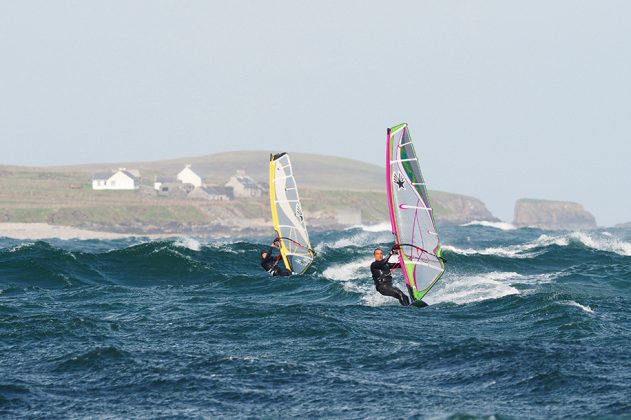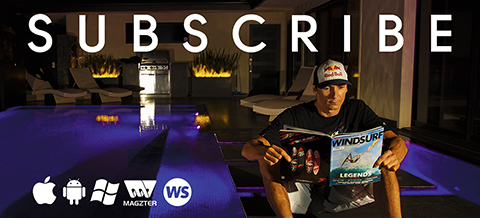“OH I DO LIKE TO BE BESIDE THE SEASIDE”
Words Peter Hart // Photos Hart Photography & Mel Cole
Originally published within the November December ’16 edition.
If you’ve thought about sea sailing but have hesitated for fear of becoming a statistic, Peter Hart offers tactical and technical advice on how to make a happy transition to open, salty water. In this first episode he concentrates on preparations for making those tentative first steps …
“Doctor – it hurts when I do this,” says the patient lifting his arm. “Well don’t do it then.” Replies the doctor (aka comedian Tommy Cooper). If your fear of the open sea is visceral and overwhelming, just don’t go there. But if you’re entertaining the idea of sea sailing but hesitate because you don’t know how to go about it; or are just being wimpishly reticent, then all you need is a plan.
Heading to the sea for the first time is not so different from learning to loop. There are two approaches. You can nibble away at it, watch videos, practice catapults and Waimaroos and flat water spins, and finally build up to having a go at the real thing near to the ground off small chop. Or, fully powered and wound up to warp speed, you can head for the biggest wave, jump 30 feet in the air, close your eyes and sheet in. In both, at some point you have to take a leap into the unknown.
You can prepare endlessly for your first sea session … or you can take whatever kit you have and drive to a spot where people windsurf and just get out there.
The latter may sound like a good way to remove an idiot from the gene pool – but actually that’s how most get into it. They tap into a modicum of common sense and live to tell the tale, although sometimes emerge a little poorer.
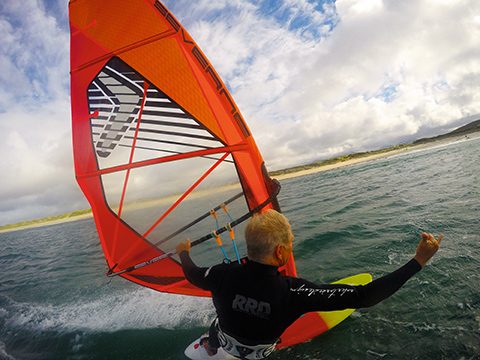
The author in 20 knots of wind on his favourite ocean, bump, jump, blast and gybe combo – 103 freestyle wave, 5.6 and 28 cm cross over fin. PHOTO Hart Photography
OCEAN KIT
Kit-wise, whatever works inland will work on the sea so don’t feel you have immediately to tool up with specialist salty models. However, taking big free-ride or racy kit (the stuff you need to exploit every inland puff) out into the rolling swells of the sea is like taking a carbon racing bike into a skate park – it’s not the tool to weave up, around and over the bumps and rollers. Fun and control comes from learning to sail smaller manoeuvre oriented kit. Once the wind reaches the magic F5, pretty much everything planes and the more sail and litres you can safely shed, the more fun you have.
Experience
In 1979 I took delivery of my brand new Sea Panther board and plucked a seaside town at random, which happened to be Bracklesham Bay. On the first run back I caught a small wave whereupon the daggerboard hydroplaned and capsized me and the rig got trashed in the shorebreak. The initiation was brief but those 45 seconds left me vastly better informed concerning:
• kit choice – don’t wave ride with a daggerboard
• wind direction – dead onshore makes getting off the beach a nightmare.
• state of tide – at this spot the shorebreak was monstrous at high water.
Learn from experience, they say, and learn from your mistakes … but try not to get all your education like that … which is why we’re here.
I say ‘we’ because I write this from Donegal in the company of twelve aspiring wave sailors who have made successful and quite recent transitions to salty
water; and are happy to say how they did it. The hardest step to make is the first one.
“ The venue and conditions have to be vaguely proportional to your standard… but the whole purpose of the exercise is surely to step a little way outside of your comfort zone ”
THE FIRST STEP
It’s like your first day at school or University. You turn up at the seashore deeply self aware, oozing inadequacy, ignorant of protocol, not knowing what to do, who to talk to, where to rig up, what to rig up. As a recently posted doctor in Newcastle, Chris O’Brien had no seaside windsurfing buddies. Social media was his saviour.
“The facebook group for the NE is great – there’s so much knowledge out there about where to go and you can become part of it gradually. It was so much better and easier than coming up to a stranger on the beach and asking him to be my new best friend.” The general advice is don’t be a loner. It is better on every level, including the all important consideration of staying healthy, to attack the new challenge with a group, or at least a couple of mates. Many inland clubs and shops organise days out to the sea. You also have virtual clubs like the ‘Ocean Motion Windsurfing Club’ who have a full calendar of weekend events at various coastal venues. The web is a rich seam of info.
A Life on the Ocean’s Waves?
Think of ocean venues and you think of waves. It’s not necessarily what you’re after first time out – but nor is it a guaranteed disaster – and besides they’re hard to avoid if your chosen spot is open to the prevailing weather. Waves of a reasonable size are fun and challenge you physically and technically. They wash you back to shore … which is nice. And if they’re too big, you wont get off the beach – so it’s kind of self-regulating. Your prospects in such conditions also depend on your kit choice – more about that in a moment.
Challenged … not petrified
In every sport the very simple rule is that to have a chance of improving you have to deal with the psychological aspects first. If you arrive at the shore, look out and feel the blood drain from your face, you will launch expecting the worst, sail terribly and develop defensive coping strategies. At the other extreme, some sheltered coves are just ponds with salt water.
This whole endeavour is surely about stepping out of your comfort zone (sailing inland it’s all too easy to slip into cosy routines.) So choose a venue that gives the true experience of sea sailing – proper open spaces and undulating water. In that regard, it’s OK to feel a bit frightened. Fear is a perfectly natural survival response and there is huge satisfaction to be gained from gradually overcoming it.
So the reaction as you survey this new venue should be: “OMG it’s all so HUGE and mildly terrifying … is that France I can see? … but I’ve sailed in bigger winds than this … and there’s a bloke out there who’s a lot worse than me and he’s managing … I’m actually quite aroused.”
“ Big inland waters can be an easier transition. Ian Booth used massive Rutland Water as
a stepping stone between little Rother Valley Country park and the sea, to help him get used to both the chop and wide open spaces. ”
Getting familiar
Only last week on a wave sailing course, I took a group of sailors offshore to sail a reef. Reef breaks are quite scary to improving wave sailors, mainly because they’re made of rock. But the challenge was far less daunting because we’d been out the day before in no wind on SUPs. We rafted up in the deep water to the side where I could explain how the reef was working, where the peak was, where to catch the wave, which way to ride and where they should swim if they got taken down. And then we paddled around over it and caught a few waves. They’d petted the tiger away from feeding time. So when the next day we sailed it in 25 knots of wind, they weren’t quivering in their neoprene socks because it was all vaguely familiar.
It’s hard to get to know a new place when it’s windy. There’s too much going on and the scenery is moving by too fast. Speed, useful in some contexts, also allows you to sail very quickly into places where you have no right to be.
So don’t be driven by Windguru stars. Make a trip to the chosen venue on a sunny, non planing day (the ocean is an altogether more welcoming place when it’s sunny and warm). Take out a big, stable, uphaul-able board and, feeling completely unthreatened by the elements or the venue, just sail around. Look back, study the coastline so you recognise the launch spot (not a given on urban shores) and take in anything, groynes, breakwaters, rocks, lobster pots, fishing lines etc, that may be a threat when you’re creaming along at 20 knots.
The happy spectator
In all new bravado situations, men especially are very good at putting themselves under pressure. “I’m here now. I’m terrified but I can’t lose face before my peers or I’ll never hear the end of it … oh God I wish I’d never agreed to this.”
Give yourself the option of doing nothing. Plan the trip so that although you’ve taken kit you really just want to WATCH. Watching is brilliant. All the good guys do it. You can get an idea of a spot on the internet but nothing beats the live experience of taking it all in. On that first trip you can lay back and note:
• where everyone is launching.
• what the wind direction is and which other directions would work.
• how the sea and conditions change with the tide – especially the shorebreak so you can time the next trip accordingly. Even more fundamentally, at some venues, like the UK’s north west coast, at low tide the sea lies somewhere off Holland. That’s good to know if you have just a two hour window.
• how far people go out.
• what happens when someone has a problem – where do they end up? How do they get back?
Hang around long enough and you are sure to slip into idle conversation. Most windies are more than happy to share their local knowledge.
“ Of course its the weather more than the venue that makes sea sailing for bidding but getting familiar with the place at a gentle pace dilutes the anxiety. ”
ELF and SAFETY
Most windsurfers are aware of their vulnerability especially when they launch onto the sea. In the millions of sailing hours practised there are staggeringly few incidents – but complacency is the enemy. I hesitate to embark on a safety lecture because once you start, a million and one potentially disastrous scenarios presents themselves. Almost all of them are avoided by a little common sense and adhering to a few simple rules.
• look at your sailing area and work out what will happen and where you will end up should you break down. Tide and wind can carry you to different places.
• “Don’t go out in an offshore wind” is what the manual says – but in many places like the NE coast, the prevailing wind is offshore, so many do. In which case don’t be the furthest one out and absolutely don’t be alone.
• the tide, its rise and fall and the stream, is the one element that surprises inland sailors. Be aware of the direction of the current. It usually runs parallel with the coast but in some places follows channels straight out to sea. Work out at what stage, the ebb or the flood, it’s going to be helping you upwind.
• Being out further than you can swim is always dodgy. It’s rare that you get separated from your kit but if the UJ snaps and board and rig separate, the board can float away faster than you can swim. Back in the 80s, 70% of RNLI or coastguard call outs for windsurfers were due to UJ failure. They’re much better now but check it for stress fractures. Have a retainer and don’t go too far out!
Let’s talk about kit in a more positive context.
PICK of the SPOTS
The constraints of time dictate that you’ll probably head to the stretch of coast nearest to home and it will be probably fine … unless you find yourself alone … in which case you have to ask yourself why. But if the world is your lobster you can get more picky. When I’m taking people off piste on wave or sea sailing trips, I favour bays. The wide sweep of a bay offers multiple launch spots according to the wind direction and in most situations catches stranded windies. The two below are dreamy venues. Both are mostly sandy bottomed, and both with low-lying headlands so clean wind blows in from all angles.
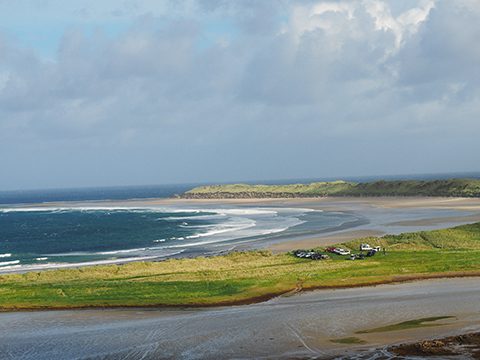
Irish perfection. This idyllic Irish bay faces north so is open to fierce North Atlantic swells – but the waves can vary from huge to tiny depending where you launch. Perfect for the sea sailor with wave sailing aspirations. PHOTO Hart Photography
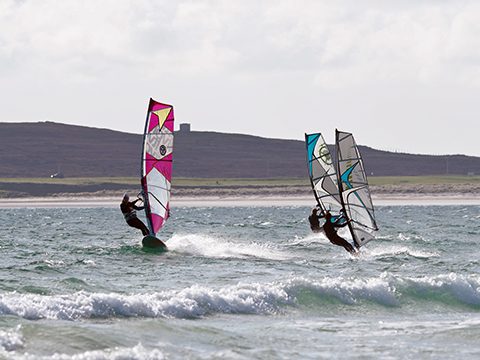
Given the choice this is where I’d take a group of first time sea sailors – Gott Bay on the island of Tiree. The aspect is totally unthreatening. White sand surrounds you on 3 sides. It faces south so generally is pretty flat but wind swell breaking gently up the shallow shelving beach gives you something to think about and project you into hops. This pic was taken 3 days ago on the first day of a wave course. 18 knots and most on about 100L fsws and 5.7s – perfect. PHOTO Hart Photography
THE JOY and DANGER of SPACE
When some sailors launch on the sea for the first time, they can be like a greyhound that’s spent its whole life shut up in a kennel. “Whoheeeeeeeee!”, you hear as they scream off towards the horizon completely oblivious to the fact they have no chance of getting themselves home should something break. On courses I have an instinctive dread of ‘horizon hunters’ having had to rescue a few. Enjoy the expanse, but try and keep it close to shore.
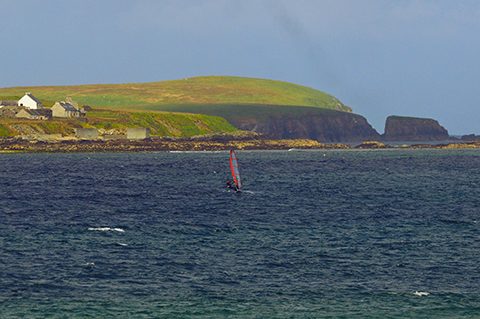
Nigel Kirkpatrick enjoying the expanse and solitude of this fabulous Irish setting. He looks a bit vulnerable but his mates are watching and there’s a beach 200m to the right. PHOTO Hart Photography
CHRIS O’BRIEN
Chris has been sailing for years and had a few light bulb moments this year which transformed his sea sailing.
“I’d been blasting around on the sea with old kit for years, loving it but not really getting anywhere technically. I’m a strong swimmer so the environment never really phased me. But this year I decided to go on a wave sailing course. That helped because it exposes all your shortcomings and really makes you think about your kit. I got a beautiful 94 fsw which makes all the difference and have got rid of all my old heavy spinnaker rigs.”
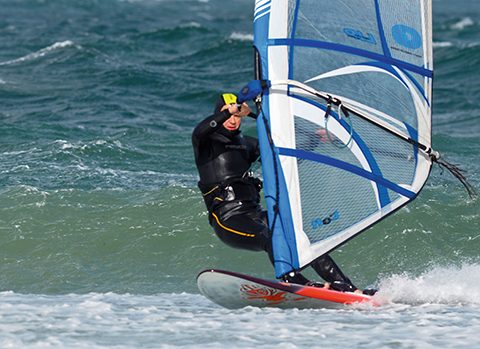
Chris’ sea sailing was transformed by investing in smaller, newer kit. PHOTO Hart Photography
KIT – smaller is usually better
I can only address this in terms of sweeping generalisations but generally the nature of inland wind – blocks of the stuff bursting through gaps in trees and valleys – persuades people onto bigger bit, which allows them to plane earlier on the front of the gust and gives them momentum to get through the ever present lulls. Many inland venues have a big kit culture and people get very good at tweaking, tuning and using it. It’s mostly about speed. On level water, you can hold down a lot of sail.
The same big kit does not work so well on the sea. For a start the wind is generally more consistent so you don’t need it. Shorebreaks love big kit. There’s so much to aim at. A wave breaking onto a 9.0 exerts so much force on the three corners that something has to burst.
In 15-18 knots an 80 kg sailor could plane with any rig from 9.5 down to 6.5. The smaller rig is lighter, more manoeuvrable and far easier to uphaul and recover in waterstarts. Waterstarting in undulating water is an extra challenge and you need all the help you can get.
As for the board – after a session in 20 knots in the rolling swells of the Red Sea, one guy commented to me he couldn’t hold the board down and his eyeballs were still shaking. I laid his board, a 150L, 85 cm wide freeride (plus 8.0 rig) board next to the 66 cm wide 103 freestyle wave I was using. Words were unnecessary.
If you’re free-riding in 12 knots over a gentle sea, of course big kit is a glorious option. But as you move into deep open water and the wind perks up towards the 20 knot mark, any swell is likely to be littered with lumps of wind chop. The wider the hull, the more it ricochets off such lumps. A narrower board not only cuts better through these hassocks but it’s easy to manoeuvre around them.
“All very well if you can sail one.” I hear you bleat. Indeed the churning sea is not the best place to try and sail smaller kit for the first time. Volume and a bit of reserve power lend mental security so you’re better off to start with on something you know and trust. But back on the lake/reservoir in preparation for the next sea session, the very best use you can make of your time is to sail that smaller board (for average adults, it’s around the 100L mark) whatever the wind. Get used to trimming it off the plane, uphauling it, turning it (tack or pivot gybe). Sail upwind off the plane using the upwind edge for resistance. As the wind gets up, practise early planing by bearing away far more than you’re used to and use the rig to power you onto the plane, not the fin. Yes it’s all about the fin.
JOHN MICHELIN – Brogborough to Ireland convert.
Life and job mean that John’s local water is Brogborough lake. Despite coming across as quite sensible and cautious, his first proper go on the sea was to sign on to a loop clinic on the south coast and from then on he has joined me annually on trips to the wild seas of Ireland. Sparing his blushes, his success is down to kit choice and training. To the consternation of his club peers, his ‘go to kit’ for Brog is his beloved 100 fsw and a 5.4 on which he can do almost everything in light or planing winds. This is what he remembers about the journey in general.
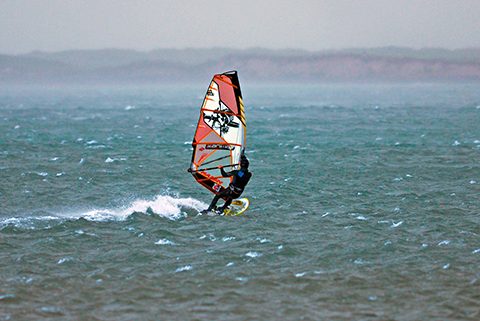
John Michelin flitting happily between Brogborough Lake and the North Atlantic. PHOTO Hart Photography
“Currents and tides, but particularly currents… At Brog the water always stays in the same place, which is quite handy. I remember being quite surprised and irritated by the side-shore drift and how much it affected trying to get on the plane, never mind the depressing site of coastline drifting past while struggling to keep upwind. The other irksome quality of sea sailing was the uppy-downy stuff. It wasn’t a swelly day, but I do remember sailing out to sea for ages, always waiting for that steady moment to attempt a tack. Which never came. A lot seems to be said about the extra buoyancy of salt water, however I never notice the difference when switching from Brog to Ireland, maybe because there’s too much else to worry about. One thing we have discussed at length on calm days at Brog is how much easier it is to plane on the sea in apparently similar wind. Theories range from the assist of a downslope to initially get going, longer period chop allowing the board to build up speed more easily without being stalled, or just the fact that sea water is much more slippery. I’m going for the latter!”
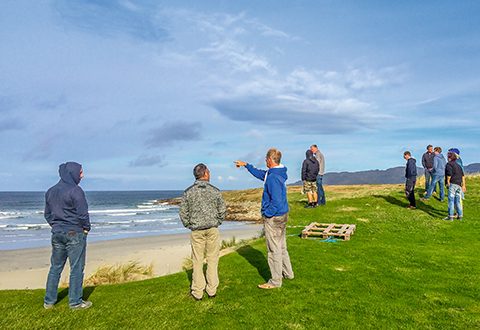
The traditional ritual of ‘sea watching.’ As a newbie sea sailor or a pro, taking time to check out the venue, clock the wind direction, currents, state of tide, obstructions, shorebreak, hopefully in the company of someone who has been there before, is time very well spent. PHOTO Mel Cole
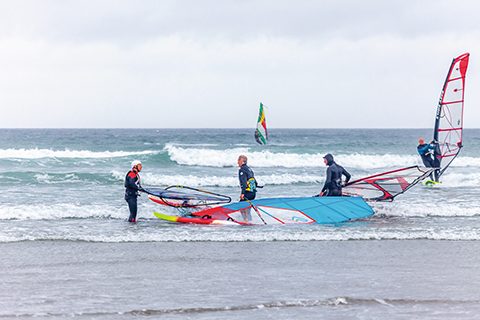
Misery loves company’ or ‘the joy of the shared experience,’ tackling the sea as a group is absolutely the way to go for so many reasons. PHOTO Mel Cole
Fin down
Away from the race track, big fins on the sea are a liability. Water sucks up in front of waves so you have an added probability of grounding out in front of them as you launch. As mentioned, the shorebreak is the worst place to catapult and dump a rig. Because of the rise and fall, it’s hard to keep a constant pressure on the fin. As you come down off a swell, you tend to load the fin suddenly, which makes the nose lift. Wind gets under the wide hull and suddenly you’re tail walking and slamming back down.
You can do what you like on the sea but surely you want to develop a style of sailing where you can exploit and enjoy the rolling swells, lift the heels into hops, make sudden changes of direction, all of which are made harder by a big fin. In free-riding you want to feel the fin lifting the board up onto those hard release edges. But in this bump, jump and gybe mode, you want the board to hold in the water. For that I see a 30cm fin as a max – but that is just a guide.
Reducing fin size forces you to modify your style, get off the back foot, and is a major step towards more controlled, manoeuvre based sea sailing.
Parting technical tips.
The autumn winds are building. In the next issue we tackle the technique part of this challenge but it would be unfair to leave you all prepared but with no ‘how to’ information. The following will be expanded upon, but here are some technique issues to think about.
Stance. Try and stand up. Those who hunker down find their backsides smacking the swells as they roll in from the windward side. And the more upright you are, the better placed you are to move from edge to edge and swerve through the lumps.
Inboard feet. The commonest cause of catapults on the sea is the front foot catching a chop or swell. The further outboard you mount your straps, the greater the likelihood. Try and get used to a more inboard foot placement.
Early planing. It’s SO much easier to initiate planing going downhill. This is the best way to start seeing the swells as your friend. And in the same vein …
Gybes. Initiate gybes on a swell so you do most of the tricky bits – the rig and foot change – with momentum going downhill.
White water. Unlike the unbroken wave, white water is moving. The more you give it to aim at, the greater the chance of it turning you round and sweeping you back. Hit it nose first and anticipate a jolt and a surge of power by dropping the hips back and sheeting out.
Harty will be writing his next piece from the glorious shores of Donegal, where he will advise you on how best to make that scary journey from
sheltered water to open ocean – and maybe even towards a wave or two. Check out his ever popular clinic schedule on www.peter-hart.com

